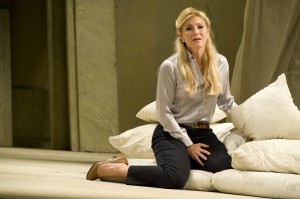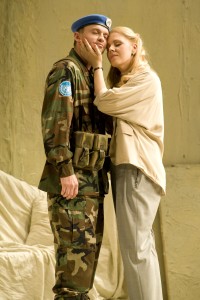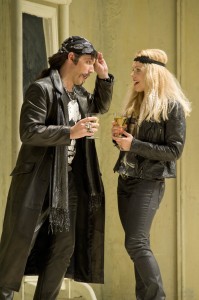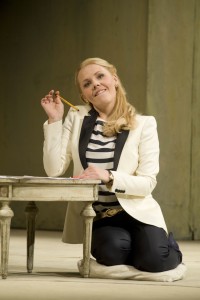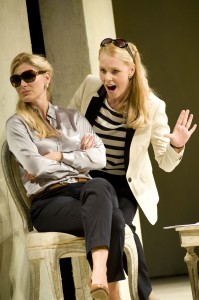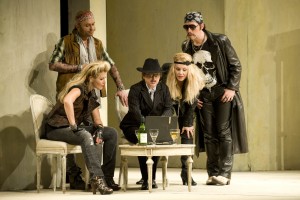Many many years ago my father took me to a performance of Cosť¨ Fan Tutte.¬† The only thing I remember about that experience is that during the intermission I told my father how disgusting I found the behavior of Guglielmo and Ferrando.¬† They expect their sweethearts to be pure and true and faithful to them, while they are perfectly free to test them in this sneaky underhanded way.¬† Dad explained to me that one shouldn’t take operatic characters too seriously; just enjoy the music and the comic situations they get themselves into.¬† Good advice then, and very apt for the production from the Royal Opera House which I attended December 4, 2010.
Opera directors frequently have an overwhelming passion for demonstrating their own cleverness and the universality of the opera by relocating its setting to a different time and/or place.  Jonathan Miller who tripled as Director, Set Designer, and Lighting Designer is no exception to this urge.  But unlike all-too-many directors, he mostly gets it right.
The location is anywhere and the time is now.¬† The “anywhere” is accomplished by using stark simplicity for the sets and props.¬† The opening scene was originally a tavern in Naples.¬† Here it is a wine bottle and three glasses on a single table with three chairs, all tucked into a front corner of the stage as if it were a box in the theatre.¬† All of the other scenes are set in a single sparsely-furnished room with a rear exit presumably to a garden and two side exits to other parts of the house.
“Now” is accomplished by contemporary dress and the judicious use of cell phones on a couple of occasions.¬† Also, the two couples were all reasonably young and reasonably trim of figure.¬† Rebecca Evans was a slightly more mature Despina but obviously still young at¬† heart.¬† And I placed Thomas Allen’s Don Alonzo as a recently retired CEO with too much money and not enough to do.
There were several nice little touches.¬† In Act I Guglielmo (St…phane Degout) and Ferrando (Pavol Breslick) are wearing business suits.¬† When they appear at the beginning of Act II, ready to go to war in the “army”, they have on camouflage outfits with the blue berets of a UN Peacekeeping force.
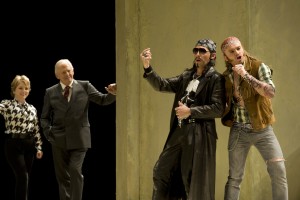
Later, when they reappear as “Albanians” they are dressed in standard non-mainstream style with bandanas, open-necked shirts, and tight pants.¬† I called them “hippies”;¬† my younger friend said “rock stars” – let’s compromise and call them “bikers”.¬† You get the idea.
Then near the end of the opera when Dorabella (Jurgita Adamonyte) and Fiordiligi (Maria Bengtsson) leave the stage to prepare for the marriages to the Albanians, they reappear as female bikers in their own right.¬† Mozart’s music proves to be good accompaniment to modern rock dance moves.
When Don Alonzo is first enlisting Despina’s aid in his nefarious scheme, they are sitting side by side.¬† He unobtrusively places his hand on her knee; she unobtrusively moves it off.¬† Ditto with an arm around her shoulder.¬† But after she has made a point and let her hand drop onto his knee, he unobtrusively lifts it back into her own lap.
In the scene where Guglielmo seduces Dorabella,¬† he asks her to close her eyes while he places his heart necklace around her throat.¬† In the usual production, he removes Ferrando’s locket to later produce as evidence.¬† Here he doesn’t disturb the locket but uses his cell phone to snap her picture showing the heart necklace.¬† This move was particularly effective for us, the HD audience, since a close up view clearly showed¬† her picture on his cell phone.
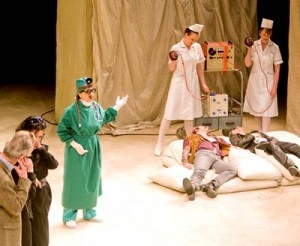
Despina disguised as a doctor with nurses and equipment (cast from 1995, but same set and costumes were used in current production) Photo: Richard H Smith/Royal Opera
There was one scene where the modernization didn’t work.¬† After the fake suicide, when Despina appears as the “Doctor” she brought two nurses and a complex aid cart with her, and the three of them used all sorts of electronic equipment.¬† I found their antics distracting and not nearly as effective as the enormous horseshoe magnet that most Despinas use.
Director Miller and Conductor Thomas Hengelbrock made dramatic use of a noticeable period of silence on a couple of occasions.¬† I particularly noticed it after Despina’s lovely aria where she urges the two sisters to relax and have fun.¬† As she leaves, there is utter silence as the girls sit stunned by her advice.¬† Dorabella in particular is in a real trance; it takes the vigorous waving of Fiordiligi’s hand in front of her face to snap her out of it and resume singing.
Mozart’s music, as always, was wonderful.¬† The singers all had good voices.¬† Their facial expressions and body language were fine – Evans and Allen were particularly good actors and fit their parts like gloves.¬† The story line was basically consistent.
Why then was I was left with a vague feeling of dissatisfaction when the final curtain came down?¬† I somehow had the feeling that no one was fully committed to the production as a whole.¬† Everyone had a job to do and everyone did it well, but I didn’t sense any great feeling of, “Wow, we really created something” which I frequently sense when the final curtain comes down.¬† It was more like, “Another day, another dollar.¬† I wonder what’s on the telly tonight?”
My friend Letha Ann didn’t agree.¬† She said, “The trouble with you is, you want the whole world with an oyster on top.”¬† Guilty as charged.¬† But why not, when comic opera performances like the MetHD of Don Pasquale that I reviewed last month show that it can exist.
If you get a chance, go see it and form your own opinion.¬† You can’t lose.¬† A B+ performance of a Mozart opera provides a more satisfying evening than an A performance of many operas!
The Opera Nut
CAMERA 7 CINEMAS
1875 S Bascom Ave
Campbell, CA 95008
408-559-6900
Photos (except where noted) © Mike Hoban/Royal Opera
This review by Philip G Hodge appeared in sanfranciscosplash.com on 12/10/10.


